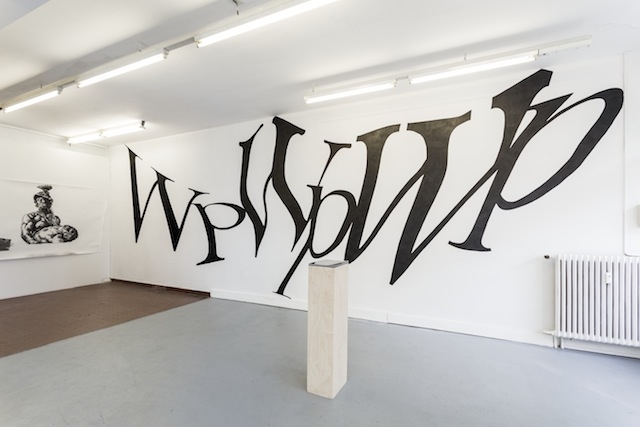Last Tango, Zürich, 7 October – 2 December
It was never going to be a fair contest. Once inside the door of Fiona Banner and Peter Voss-Knude’s two-hander exhibition, Banner’s mural WpWpWp (2014–17), a typographically distorted onomatopoeic description of a helicopter’s whipping blades, dominates the space, flooding it with an absorbing conception of sound and movement. When it comes to harnessing the imagery of armed forces and conflict – subjects the artists have in common – the British Banner has a couple of decades’ head start over the Danish Voss-Knude, though this show equally demonstrates her recent interest in the corporate context. Nose Art (2015) positions two Harrier jet noses side by side, high on the wall, sleek sides patterned with fine graphite stripes borrowed from corporate fashion. These might be the breasts of an immense Amazon, or maybe a rebuttal of Allen Jones for the post-Weinstein age. Invited to collaborate by the Archive of Modern Conflict in London, Banner in turn commissioned an extensive photographic portrait of the City of London by war photographer Paolo Pellegrin, which became illustrations for Banner’s 2015 version of Joseph Conrad’s 1899 novella Heart of Darkness. With astonishing economy, Banner implicates the City, and by extension the British establishment, in Conrad’s story of aggression, profiteering and masculine brutality, presenting it meanwhile in the glossy format of a high-fashion magazine. (Pellegrin’s pratfall shot of a suit jacket blown by the wind to reveal the wearer’s striped suited bottom informs many subsequent works, including Nose Art.)
Voss-Knude’s interests lie in the interpersonal bonds that enable men – principally – to fight together. His media are varied, from musical collaborations with soldiers recorded by his band Peter & The Danish Defence, to drawing and installation. At Last Tango he replies to Banner with the nearly four-metre-wide charcoal drawing One Statue, Two Eyes (2017), which depicts a Florentine statue of two men who fought in Homer’s The Iliad, Menelaus carrying dead Patroclus. The statue is drawn in two parts, the lower halves and pedestal on the left, Menelaus’s helmeted head and the slumped figure he carries in the righthand half. This fracturing and zoning in on bodies continues with the comical honouring of the Male Version of a Sports Bra (2014), a bronze cast of a jockstrap pinned to the wall around groin level.
Both artists occupy a small additional space for their work alone. In hers, Banner has Spooning Chairs (2015) from a series of bent plywood chairs equally striped in graphite, this pair lying side by side on the ground contemplating the orange fluorescent paper and graphite work Pinstripe Bum Face (2015). Voss-Knude’s works benefit from their isolation, in which he continues his fragmentary approach with two 2011 pencil drawings, Waterfall seen out of the window of a police car and Jungle seen out of the window of a police car. Dating from a time when he was studying in London and applied (unsuccessfully) to become a police special constable, they are roughly car-window shaped, blurred and incomplete. Here too, displayed on a windowsill, is another synecdoche: He Weaves (2009–17), a greying vest, into the front of which have been woven countless tiny metal bars, each about a centimetre long, turning the cotton dark silver. By rights it should be a piece of armour, but it functions more like a fallen torso: he weaves, he writhes, he is human and vulnerable after all.
From the December 2017 issue of ArtReview
